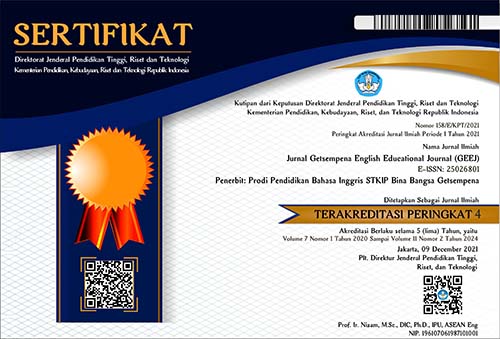ANDROID-BASED MOBILE LEARNING MEDIA IN TEACHING READING OF REPORT TEXTS
Abstract
Mobile phones can be well integrated into English Instruction as the creativity and innovation of teaching media increase students’ interest and motivation. This research aims to reveal the validity, effectiveness, and practicality of utilizing Android-based Mobile Learning Media for teaching reading report texts. The present research employed the research and development design. The research instruments were questionnaires, tests, and learning media in Application Package Files (APK). The collected data were analyzed by employing descriptive statistics and inferential statistics with a t-test. This research’s subject was an experimental class and a control class in Senior High School of Muhammadiyah 2 of Purbalingga. The expert validation results were categorized into relevant and feasible learning media to teach report texts. The pre-test and post-test mean scores in the experimental class showed a highly significant difference because the class outperformed the control class. It means that Android-based MLM was effective for enhancing students’ reading comprehension of report texts. Meanwhile, the result of students’ perception obtained a good category. The data reveal that 70.4% of the students agreed to use Android-based MLM in the learning process. This research concludes that the final product meets the criteria of teaching media evaluation.
References
Ananto, P., & Ningsih, S. K. (2020). Incorporation of Smartphones and Social Media to Promote Mobile Learning in an Indonesian Vocational Higher Education Setting. International Journal of Interactive Mobile Technologies, 14(19), 66–81. https://doi.org/10.3991/ijim.v14i19.13863
Cahyana, U., Paristiowati, M., & Fauziyah, S. (2018). Development of Android-Based Mobile learning media on Atomic Structure and Periodic Table. IOP Conference Series: Materials Science and Engineering, 434(1), 1–7. https://doi.org/10.1088/1757-899X/434/1/012095
Chen, T. H., & Lin, C. C. (2018). Enhancing L2 English Learning through Mobile-Assisted TBLT: EFL Learners’ Perspectives. The Journal of Asia TEFL, 15(2), 453–461. https://doi.org/10.18823/asiatefl.2018.15.2.1.453
Elfiona, E., Zaim, M., & Refnaldi. (2019). Mobile-Based Media as the Solution in Teaching and Learning Listening Skill. Journal of Physics: Conference Series, 1387(1), 1–6. https://doi.org/10.1088/1742-6596/1387/1/012024
Hao, Y., Lee, K. S., Chen, S. T., & Sim, S. C. (2019). An evaluative study of a mobile application for middle school students struggling with English vocabulary learning. In Computers in Human Behavior (Vol. 95). https://doi.org/10.1016/j.chb.2018.10.013
Helwa, H. (2017). Using Mobile Assisted Language Learning (MALL) Approach for Developing Prospective Teachers’ EFL Listening Comprehension Skills and Vocabulary Learning. Journal of Research in Curriculum Instruction and Educational Technology, 3(4), 133–176. https://doi.org/10.21608/jrciet.2017.24440
Keezhatta, M. S., & Omar, A. (2019). Enhancing Reading Skills for Saudi Secondary School Students through Mobile Assisted Language Learning (MALL): An Experimental Study. International Journal of English Linguistics, 9(1), 437. https://doi.org/10.5539/ijel.v9n1p437
Klimova, B., & Polakova, P. (2020). Students’ perceptions of an EFL vocabulary learning mobile application. Education Sciences, 10(2). https://doi.org/10.3390/educsci10020037
Mulyadi, D., Wijayatingsih, T. D., Budiastuti, R. E., Ifadah, M., & Aimah, S. (2020). Technological pedagogical and content knowledge of ESP teachers in blended learning format. International Journal of Emerging Technologies in Learning, 15(6), 126–139. https://doi.org/10.3991/ijet.v15i06.11490
Naderi, S., & Akrami, A. (2018). EFL learners’ reading comprehension development through MALL: Telegram groups in focus. International Journal of Instruction, 11(2), 339–350. https://doi.org/10.12973/iji.2018.11223a
Ocepek, U., Bosnić, Z., Nančovska Šerbec, I., & Rugelj, J. (2013). Exploring the Relation between Learning Style Models and Preferred Multimedia Types. Computers and Education, 69, 343–355. https://doi.org/10.1016/j.compedu.2013.07.029
Rahim, M. I., Kamarudin, R., Sheha, S., Aziz, S., & Karim, N. A. (2019). Students ’ Perception S On The Use Of Mobile Application For English Course ( Mapec ) As A Pre-Language Learning Tool. Journal of Academia UiTM Negeri Sembilan, 7(1), 11–21.
Trimurtini, T., Liftiah, L., & Ahmadi, F. (2018). The Development of Android-Based Mobile Learning Media (MLM) for Elementary School Students of Kendal Indonesia. UNNES International Conference on Research Innovation and Commercialization 2018, KnE Social Sciences, 2019, 694–705. https://doi.org/10.18502/kss.v3i18.4759
























